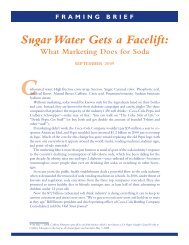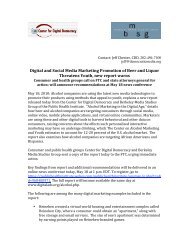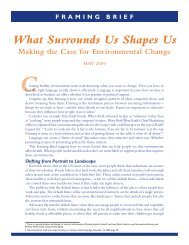"Interactive Food & Beverage Marketing" (PDF)
"Interactive Food & Beverage Marketing" (PDF)
"Interactive Food & Beverage Marketing" (PDF)
You also want an ePaper? Increase the reach of your titles
YUMPU automatically turns print PDFs into web optimized ePapers that Google loves.
<strong>Food</strong> marketers can<br />
now target teens<br />
through an explosion<br />
of new digital<br />
venues—including<br />
social networking<br />
platforms, peer-topeer<br />
video, instant<br />
messaging, interactive<br />
games, and cell<br />
phones—completely<br />
bypassing any parental<br />
oversight.<br />
<strong>Interactive</strong> <strong>Food</strong> & <strong>Beverage</strong> Marketing | Creating a Healthy Media Environment for the 21st Century<br />
clear, in a manner that will be easily understood by the intended audience, that it is an<br />
advertisement.” 288 But these new rules are most likely to result in only minor alterations<br />
of online children’s advertising, such as the addition of “sponsored by” in advergames<br />
and other forms of branded entertainment. They have been so carefully and narrowly tailored<br />
that it is doubtful whether they will affect most of the new marketing strategies documented<br />
in this report. 289<br />
One of the biggest weaknesses in the industry self-regulation programs is that<br />
they apply only to advertising that is targeted exclusively to children 12 and under. This<br />
approach is part of a tradition in U.S. regulation, dating back to the 1970s, when<br />
research documented that young children were unable to understand the intentions of<br />
others and were therefore vulnerable to advertising. 290 But we cannot address the nutritional<br />
health problems facing America’s young people by narrowly focusing attention only<br />
on the youngest segment of the youth population. The Institute of Medicine’s comprehensive<br />
study was concerned with food consumption by all children, 18 and under. 291<br />
Adolescents may be even more at risk of consuming a “high-calorie, low-nutrient” diet<br />
than younger children. Teens spend more of their own money on food, make more of their<br />
food choices independently of their parents, and do more of their food consumption outside<br />
of the home. <strong>Food</strong> marketers can now target teens through an explosion of new digital<br />
venues—including social networking platforms, peer-to-peer video, instant messaging,<br />
interactive games, and cell phones—completely bypassing any parental oversight. And<br />
because the Children’s Online Privacy Protection Act (COPPA) protects only children under<br />
the age of 13, adolescents are also subjected to some of the most extensive behavioral<br />
marketing in contemporary media.<br />
In the new world of digital media, clear demarcations of age are increasingly<br />
blurred. Many of the current websites and online platforms are directed at broad demographic<br />
categories encompassing children, teens, and young adults. 292 For example, a<br />
report by the industry trade publication eMarketer View explained that “tweens” are “children<br />
(boys and girls) who are between the ages of 8 and 11,” while pointing out that<br />
“some researchers include ages as low as 7 and as high as 14” in the “tween” category.<br />
The report identified “young teens” as between 12 and 14 and “youths” as between the<br />
ages of 12 and 17. 293 In the virtual world of Whyville, “tweens” are defined as 8-15. 294<br />
The interactive game service XFire says that it targets “males 14-35.” 295 And Bolt.com<br />
explains to prospective advertisers that 31 percent of its “target demo” of 5.5 million<br />
monthly users falls into the age range of 12-17, even though its privacy policy says it is<br />
targeted to 13 and over. 296 Such confusing configurations suggest a media environment<br />
in which the traditional concepts of age no longer apply. Just as advertising and content<br />
are conflated, so are the very categories of childhood.<br />
65









